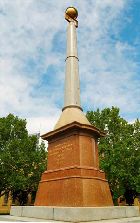Multimedia Content
image
- Title
- Eight Hour Day Memorial
- Date
- 1900 - 1903
- Place
- Corner of Russell and Victoria Streets
- Interpretive description
Born in London, Percival Ball studied at the Royal Academy of Arts, where he exhibited frequently. He lived in Europe before coming to Australia in 1884, establishing a studio in Collins Street. Ball produced several works in Melbourne, namely the Francis Ormond and Sir Redmond Barry statues, as well the statue of Sir William Blake in Ballarat. We suspect, but are not certain, Ball created the Eight Hour Day Memorial.
This publicly funded monument was designed to commemorate the eight-hour working day, introduced on the 21 April 1856. In February 1856, stonemasons working at the University of Melbourne marched on Parliament House, pressing claims for a regulated eight-hour working day. The skilled workers were in a good position to have their claims met; Melbourne was experiencing a building boom and some of the city's great public buildings, such as the Public Library (now known as the State Library of Victoria), were under construction. After weeks of protest, the workers became the first in the world to achieve a 48-hour working week. The '888' on the top of obelisk refers to the workers' popular slogan: eight hours' work, eight hours' rest and eight hours' recreation. Around the monument's globe the inscription reads: 'Labour, Recreation, Peace'. While the eight-hour day was an important achievement for the building workers, conditions for women and child labourers in particular remained unchanged and unreasonable for decades.
The monument was unveiled in 1903 and 14 surviving pioneers of the eight-hour-day movement attended the ceremony. Mr Ward, MLA, claimed in his keynote address that the 'pioneers had led the way, not only for Victoria, but for the rest of the world'.
Originally located in Gordon Reserve, Spring Street, the monument was moved to the corner of Russell and Victoria Streets in 1923. Its site near Parliament House, it was, perhaps, a spur to reform, although the present site opposite Trades Hall is wholly appropriate. Its presence near Parliament House was said to offend the conservative members, hence its relocation.- Physical description
Granite, bronze and gold-leaf monument with stone pedestal
- Creator
- Percival Ball (?)
- Archival Source
- Art and Heritage Collection; City of Melbourne. Details
- Rights
- Courtesy City of Melbourne
Related Entries
Entries
Created: 31 July 2008

